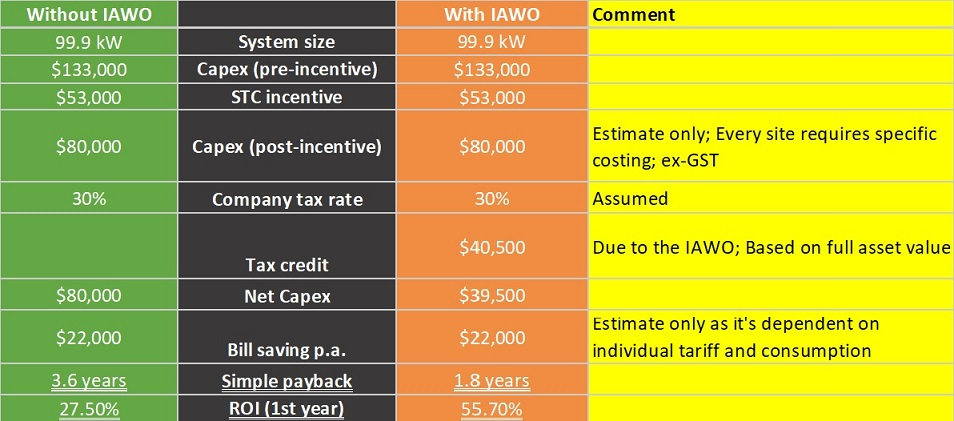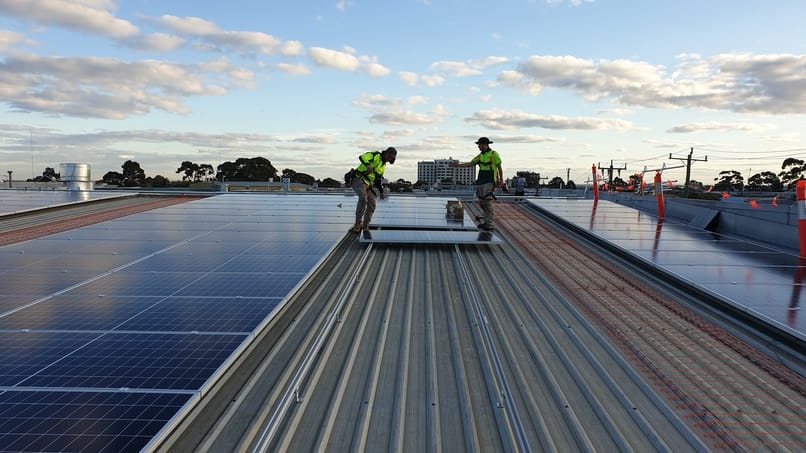If you’re thinking of switching to solar power for your business, then make sure you benefit from the available rebates, grants, and incentives.
It can be confusing to keep up with the changes that federal and state government make to these programs. This article is a rundown of what’s currently available for Australian businesses, from the national and state levels to the council level.
Read on to learn about incentives that can help you accelerate payback time for your commercial solar power system. See for yourself if switching to solar will be worthwhile.
Federal government’s renewable energy certificates
A renewable energy certificate (REC) consists of two types of certificates issued by the federal government under the Renewable Energy Target. They are small-scale technology certificates (STCs) and large-scale generation certificates (LGCs).
Small-scale technology certificates (STCs)
These are for businesses that install solar panel systems less than or equal to 100kW. One STC is generally equivalent to 1 MWh of (expected) renewable electricity generated by a small generation unit.
After getting an STC, a value is created, which can be redeemed by selling or assigning them. The number of STCs created is based on the amount of renewable energy the system produces and saves, and the climate region where it’s installed.
STCs are commonly surrendered to solar retailers, so the businesses purchasing the system gets a significant point of sale discount. The higher the value of the STC, the better the upfront discount, payback, and return on investment. It’s a fast and hassle-free approach and reduces the problems arising from attempting to trade the certificates independently. Since the first quarter of 2021, STC prices have consistently been high, encouraging businesses to go for a sub-100kW solar PV system.
Large-scale generation certificates (LGCs):
These certificates are for businesses installing solar panel systems over 100kW, which at this point is deemed as a ‘power station’. One LGC is equivalent to 1 MWh of renewable electricity generated above the power station baseline. Wind and solar farms, and hydroelectric schemes, which are large-scale renewable energy projects are entitled to LGCs.
LGCs benefit your business as an ongoing revenue stream instead of an upfront discount on the system cost. What determines the number of LGCs created is the amount of electricity generated calculated on a monthly basis using a formula from the Australian Government’s Clean Energy Regulator.
Once you gain and register your LGC, it can be transferred to other parties, so for example, you could sell it to energy retailers. Sale prices can be negotiated here depending on where the demand and supply are at.
Using STCs and LGCs
Both certificates are tradeable commodities connected to eligible installations of solar power systems and other types of renewable energy. For commercial solar farms, the value of these commodities can be thousands of dollars.
Some suppliers provide businesses with a point of sale discount if you elect to sign over your STCs or LGCs to them. This saves time and hassle over attempting to trade the certificates yourself, but it’s worth making this decision carefully and undertaking due diligence.
Note that the federal government has decided to slowly phase out the program under which these certificates operate. The number of certificates issued to each installation will decrease annually, reaching zero in 2030.
Federal government’s October 2020 economic stimulus
The instant asset write-off outlined by the economic stimulus enables eligible businesses a deduction in the full cost of new eligible depreciating assets. These assets are to be first used or installed from 7:30 pm AEDT on 6 October 2020 until 30 June 2022. Compared to pre-budget changes with the asset threshold limit of $150,000, these full-cost deductions have no limit on value. They can also be claimed across multiple assets.
For many business owners, the barrier to entry for commercial solar power has been seeing a return on investment in the short-term, or high upfront costs. The payback and ROI of commercial solar are now beneficial, being boosted by this tax offset program.
Below is a practical illustration of how the instant asset write-off enables a medium-size 99.9kW solar PV to have an ROI of 55.7%^.

Incentive programs in Victoria
A range of subsidies and financing options are available for Victorian businesses to install solar power and solar hot water upgrades.
New ‘solar for business’ rebates
Bringing down energy bills for small businesses, this rebate reduces the upfront cost of installation of an approved small-scale solar PV system up to 30kW.
To support the economic recovery of Victorian small businesses and the broader solar sector, 15,000 solar PV rebates will be available over the next three years. However, there’s only a limited number available for every period. From May 2021, rebates will cover up to 50 per cent of the cost of a rooftop solar system. Small businesses are eligible for a rebate of up to $3,500 to reduce the upfront cost of installing solar on their business premises.
Eligibility for receiving a small business solar rebate includes the following criteria:
- to be the owner of a business that has less than 20 employees;
- to operate from premises that are not considered residential;
- to operate from premises that are individually metered;
- have your system installed by a Solar Homes approved solar retailer as detailed on Solar Victoria’s website;
- install a solar system with a PV capacity size up to 30kW, and detailed on the Solar Homes approved product list.
On-farm energy grants
This is a solar grant for farmers; it’s part of the Agriculture Energy Investment Plan Extension (AEIP). Supporting farm businesses to reduce energy costs, the plan improves energy efficiency and explores alternative energy options. Applications for grants and assessments under the first round of AEIP opened in late-2018 and closed in mid-2020. Additional funding has been provided in the 2020-21 Victorian Budget to extend the AEIP, and the grants are available until 15 December 2021.
The grant benefit can be up to $250,000 ex GST in matched funding (dollar-for-dollar). The majority of the solar power generated must be utilised on-farm for it to be an eligible expense. Exporting to the grid isn’t preferred but will be considered on a case-by-case basis. Solar installations on residential buildings or connected to the residence meter are ineligible for AEIP funding. Exceptions will be considered where farm building or equipment is connected to the residence meter and the level of on-farm energy use is clearly identified and measurable.
A key criterion is that the farm needs to be a primary producer, spending at least $8,000 per year on energy, including electricity, gas, LPG and diesel. Check the Business Victoria website for more information on the details of the eligibility criteria.
Incentive programs in NSW
In addition to federal solar subsidies, FiTs, and low-interest loans, the NSW government has implemented a $1 billion program to provide long-term low-interest loans to farmers for capital expenditure.
Farm innovation fund
Farmers can apply to borrow up to $1 million for capital expenditure, including solar power systems, to improve permanent on-farm infrastructure. Interest charges for the 2019-20 period will be waived. It also offers loans for up to 20 years at low-interest rates. Loans are available for up to 100 per cent of the net cost of the works, such as installing solar panels. The interest rate will be fixed for the term of the loan at a competitive rate, which is currently 2.5% as of March 2020. Learn more about this fund on their page.
Incentive programs in the ACT
ACT businesses can take advantage of beneficial rebates for installing battery storage.
Next-generation energy storage program
The program provides businesses with a rebate when installing battery storage systems. As one of the largest rollouts of batteries in the world, this program began in 2016 to stimulate the rollout of distributed solar energy storage in the state. It also assists the development of the ACT-based energy storage industry, research, and training. Finally, it extends ACT’s national leadership position in renewables.
Eligible businesses can receive a rebate of $3,500 (ex GST) or 50% of the battery price (ex GST) - whichever is the lowest. To be eligible for a rebate, your new battery system must fulfil four requirements:
- be a new system that has not already been supported by the program
- be connected to the electricity grid
- be coupled with solar panels
- include a new or existing inverter that meets the necessary requirements.
Learn more about this energy storage program on the ACT government page.
Local government incentives
Environmental Upgrade Finance (EUF) is a flexible $0 outlay, positive-cashflow method of utilising solar that can benefit owner-occupiers, tenants, and landlords. This EUA is facilitated by many local Councils in VIC, NSW, and SA. The key benefits of EUFs depend on whether you’re a tenant or a landlord.
The benefits for tenants
- Some no-repayment period
- Immediate cash benefits
- Finance GST and claim back on BAS statement
- Demonstrate a practical commitment to sustainability
- The repayment can be transferred to another tenant when the business moves
- There’s no additional personal security required
- Terms up to 20 years available.
The benefits for a landlords
- Tax credits of up to $45,000 (for a 100kW system or much more for larger systems) due to the new instant asset write-off
- Improve the value of the building or make it more attractive to tenants without capital outlay
- Demonstrate a concrete gesture to support the tenant with cost reduction and sustainability.
While we’ve undertaken extensive research before presenting this article, the rebates and incentive inevitably change and evolve in Australia. It can be confusing and hard to keep up with how much incentive applies to your business at any given time.
If you’re considering solar or battery power, please get in touch with our friendly team for guidance.
Sources
- Clean Energy Regulator - REC Registry
- Rebates and Assistance - Department of Industry, Science, Energy and Resources
- Next Generation Energy Storage ACT - Business.gov.au
- Minimum feed-in tariff - Essential Services Commission
- Solar for Business - Solar Victoria
